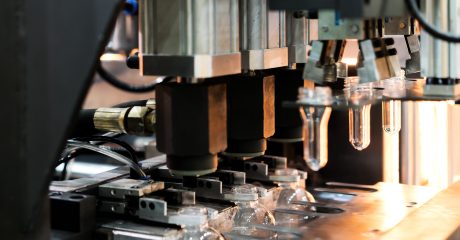Injection and blow molding are plastic manufacturing processes for making parts with commercial and industrial applications. Both processes are different, although often confused for each other due to the word “molding.” As a result, enthusiasts need to understand how blow molding and injection molding compare to accurately decide on the right one. This article introduces blow and injection molding along with their applications and advantages.
What is Blow Molding?
Blow molding is a plastic molding process that is similar to glassblowing. The process begins by heating the raw plastic material to a certain temperature (depending on the plastic). Afterward, an extrusion machine extrudes the heated plastic material to form a hollow tube, a.k.a parison.
The operator places the parison in a prepared mold and blows air (pressure of about 80psi) to the mold. As a result, the parison expands in the mold, taking its shape. On cooling, the plastic sets and forms the hollow parts according to the mold design. Delegating then occurs.
Advantages of Blow Molding
The blow molding process has the following advantages:
- It has a lower production cost in comparison with injection molding
- It has a low initial machine investment
- It eliminates the need for a two-part mold component
- It has great part design flexibility
Applications of Blow Molding
Blow molding is highly cost-effective and functionally effective. Consequently, it is an important process in making uniform and thin-walled hollow components. Small businesses in industries such as automotive, consumer products, medical parts, pharmaceuticals, etc., use it in making hollow parts such as bottles, water tanks, etc.
What is Injection Molding?
Injection molding involves using precision molds and tooling to manufacture solid plastic parts. The mold is the component with the final product’s design made from materials such as steel and aluminum using a high precision and tolerance process such as CNC machining.
On designing and manufacturing the mold, the injection process starts. The first stage involves melting the injection molding material at a very high temperature (depending on the plastic polymer). Furthermore, the operator injects the molten plastic into the mold at high pressure. After injection, cooling occurs to harden the plastic polymer, and then ejection occurs. You can also subject the part to a surface finishing process.
Advantages of Injection Molding
Injection molding has the following advantages:
- Development of highly detailed molds with multi-cavity options
- It has a high precision
- It is cost-effective for high-volume production
- It has great material flexibility, color options, and efficiency
Applications of Injection Molding
Injection molding is applicable in the volume production of solid parts with great details and high precision. For example, container caps, combs, and mobile phone cases. It is also applicable in the automotive parts and medical parts manufacturing industry.
Contact Custom Tool Today!
When you need a custom tool, you need a partner who can meet you more than halfway, whether you’re developing a new tool or looking for a way to manage your existing inventory. Customers trust us to meet this need for three main reasons: experience, quality and fast delivery! Contact us today for more information.
